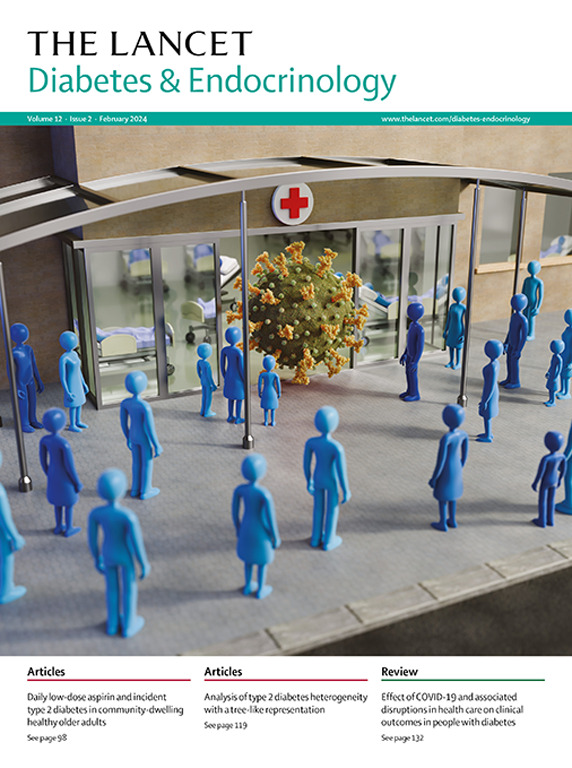产后头 6 个月的胰岛素自动给药(AiDAPT):预设扩展研究
IF 44
1区 医学
Q1 ENDOCRINOLOGY & METABOLISM
引用次数: 0
摘要
背景:在英国和其他地方的临床指南并没有专门解决混合闭环(HCL)在产后期间的使用,当照顾新生儿的需求是至关重要的。我们的目的是评估产后前6个月使用盐酸的安全性和有效性,并与标准护理进行比较。方法在这项预先指定的多中心随机对照试验中,对英国9个地点的1型糖尿病孕妇进行了产后6个月的随访。符合条件的参与者(在实施产后方案修订批准后招募的AiDAPT参与者,在实施修订时仍怀孕或分娩6个月内仍在使用HCL或持续血糖监测[CGM]治疗的参与者)继续其随机分配的治疗,标准胰岛素治疗加CGM或HCL治疗(CamAPS FX系统版本0.3.1,CamDiab, Cambridge, UK)。参与者按1:1的比例随机分组,按临床部位分层,随机分组大小为2或4。主要终点是在产后0 ~ 3个月、3 ~ 6个月和6个月以上测量的组间百分比时间差异([TIR] 3.9 ~ 10.0 mmol/L [70 ~ 180mg/dL])。该研究已在ClinicalTrials.gov注册(ISRCTN56898625)并已完成。在124名AiDAPT试验参与者中,66名(53%)不符合纳入产后延长的条件,57名参与者同意按照最初的随机分配继续接受治疗。平均年龄31岁(SD 4),所有参与者的早期妊娠HbA1c均为59.4 mmol/mol (SD 10.5 [7.6% SD 1.0%])。产后6个月,与标准护理组相比,HCL组血糖水平在目标范围内的平均时间更高(72% [SD 12%] vs 54%[17%]),调整后的治疗差异为15% (95% CI 7至22)。高血糖(10.0 mmol/L)和平均CGM葡萄糖也有利于HCL(分别为-14% [95% CI -23%至-6%]和-1·3 mmol/L[-2·3至- 0.3])。低血糖率低,组间无差异(2.4% vs 2.6%)。没有治疗效果的变化取决于产后时间(0至3个月vs 3至6个月),没有意外的安全问题。HCL组的参与者在产后6个月内维持70%的TIR,支持糖尿病患者在分娩后继续使用HCL而不是标准胰岛素治疗。美国国家健康研究所,青少年糖尿病研究基金会,糖尿病研究;健康的基础。CGM设备由Dexcom以折扣价提供。本文章由计算机程序翻译,如有差异,请以英文原文为准。
Automated insulin delivery during the first 6 months postpartum (AiDAPT): a prespecified extension study
Background
Clinical guidelines in the UK and elsewhere do not specifically address hybrid closed loop (HCL) use in the postpartum period when the demands of caring for a newborn are paramount. Our aim was to evaluate the safety and efficacy of HCL use during the first 6 months postpartum compared with standard care.Methods
In this prespecified extension to a multicentre, randomised controlled trial, pregnant women with type 1 diabetes at nine UK sites were followed up for 6 months postpartum. Eligible participants (AiDAPT participants recruited after the implementation of the postpartum protocol amendment approval, those still pregnant or within six months of delivery at the time of amendment implementation and still using HCL or continuous glucose monitoring [CGM] therapy) continued their randomly assigned treatment, either standard insulin therapy with CGM or HCL therapy (CamAPS FX system version 0.3.1, CamDiab, Cambridge, UK). Participants were randomised in a 1:1 ratio with stratification by clinical site using randomly permuted block sizes of 2 or 4. The primary outcome was the between-group difference in percentage time in range ([TIR] 3·9–10·0 mmol/L [70–180mg/dL]), measured during the periods of month 0 up to 3, months 3 to 6, and over 6 months postpartum. The study is registered at ClinicalTrials.gov (ISRCTN56898625) and is complete.Findings
Of the 124 AiDAPT trial participants, 66 (53%) were ineligible for inclusion in the postpartum extension, and 57 participants consented to continue their treatment per original random allocation. The mean age was 31 years (SD 4), and all participants had early pregnancy HbA1c 59·4 mmol/mol (SD 10·5 [7·6% SD 1·0%]). In the 6 months postpartum, mean time with glucose levels within the target range was higher in the HCL group compared with the standard care group (72% [SD 12%] vs 54% [17%]), with an adjusted treatment difference of 15% (95% CI 7 to 22). Results for hyperglycaemia (>10·0 mmol/L) and mean CGM glucose also favoured HCL (–14% [95% CI –23% to –6%] and –1·3 mmol/L [–2·3 to –0·3], respectively). Hypoglycaemia rates were low, with no between-group differences (2·4% vs 2·6%). There were no treatment effect changes depending on postpartum period (0 up to 3 months vs 3 to 6 months) and no unanticipated safety problems.Interpretation
Participants in the HCL group maintained 70% TIR during the first 6 months postpartum, supporting continued use of HCL rather than standard insulin therapy for people with diabetes once they have given birth.Funding
National Institute for Health Research, Juvenile Diabetes Research Foundation, and Diabetes Research & Wellness Foundation. CGM devices were provided by Dexcom at a discounted price.求助全文
通过发布文献求助,成功后即可免费获取论文全文。
去求助
来源期刊

The Lancet Diabetes & Endocrinology
ENDOCRINOLOGY & METABOLISM-
CiteScore
61.50
自引率
1.60%
发文量
371
期刊介绍:
The Lancet Diabetes & Endocrinology, an independent journal with a global perspective and strong clinical focus, features original clinical research, expert reviews, news, and opinion pieces in each monthly issue. Covering topics like diabetes, obesity, nutrition, and more, the journal provides insights into clinical advances and practice-changing research worldwide. It welcomes original research advocating change or shedding light on clinical practice, as well as informative reviews on related topics, especially those with global health importance and relevance to low-income and middle-income countries. The journal publishes various content types, including Articles, Reviews, Comments, Correspondence, Health Policy, and Personal Views, along with Series and Commissions aiming to drive positive change in clinical practice and health policy in diabetes and endocrinology.
 求助内容:
求助内容: 应助结果提醒方式:
应助结果提醒方式:


